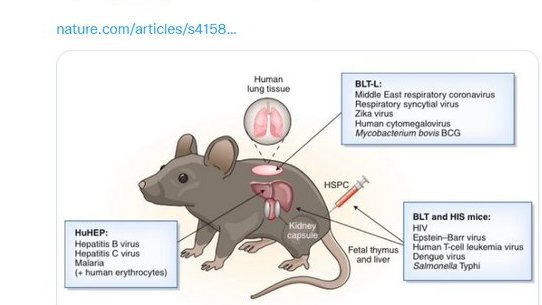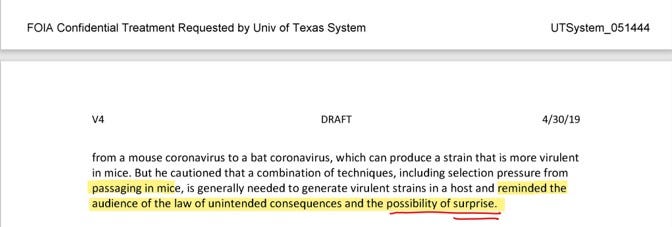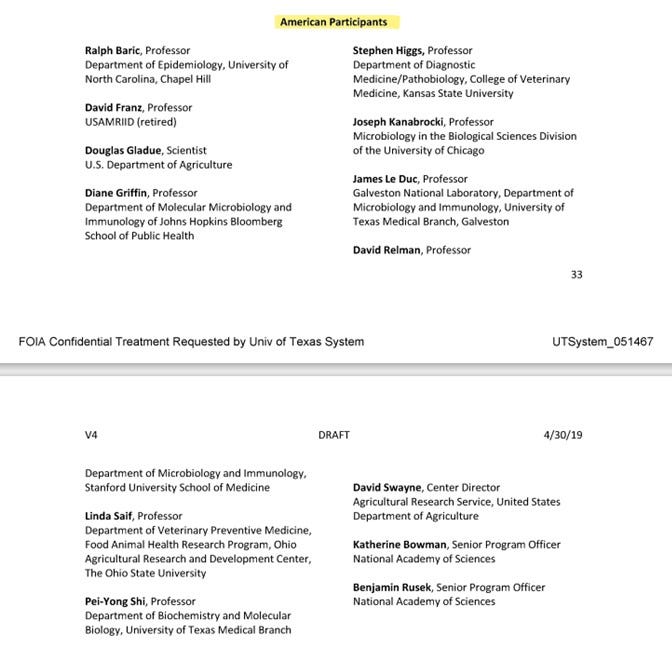In Jan. 2019, U.S.-funded coronavirus researchers met in China
One covid expert, Dr. Ralph Baric, cautioned his colleagues about "the possibility of surprise" when dealing with viruses with pandemic potential.
Newly released documents show University of North Carolina’s (UNC) coronavirus expert Dr. Ralph Baric and other key U.S. coronavirus researchers were in China in January 2019, meeting about viral infectious disease research.
Dr. Baric talked about making pandemic-like bat viruses more deadly, cautioned workshop attendees about "passaging in mice[,]" and reminded “the audience of the law of unintended consequences and the possibility of surprise.”
Of mice and men
U.S. and Chinese scientists got together from January 8-10, 2019. They met in Harbin, China, at an institute that houses a BSL-4 lab, the kind where researchers wear special pressurized moon suits and research deadly viruses and other pathogens.
In 2018, the year before the Harbin, China workshop, some of the same attendees applied to the U.S. Department of Defense’s secret DARPA program, asking for $14 million to study bat viruses. Their pitch was to put bat viruses into “humanized” mice, watch them get really sick, and then make a vaccine to fight coronavirus. This group of international collaborators, instead of giving a covid vaccine to humans, proposed to spray their vaccine on bats in China’s Wuhan lab and in Chinese caves, to vaccinate and inoculate the bats. (DARPA turned them down and did not fund their proposal, as I detailed in depth here.)
Some scientists have speculated that the 2018 DARPA pitch went forward anyway with other funding. Some think NIH, specifically Dr. Anthony Fauci’s shop, funded the idea (in whole or part) through NIH or perhaps the idea was funded through another DOD agency, or USAID. Some speculate the Chinese funded it. We don’t know and nobody is saying, but people have noted the secrecy surrounding this work.
As shown in this photo, many U.S.-funded bat virus researchers also attended a meeting in Wuhan in October 2018, called, “The 8th International Symposium in Emerging Viral Diseases.”
2019: “Engineering” Dangerous, Viral Pathogens
On the first day of the 2019 China workshop, there was a session titled “Understanding and Engineering Viral Pathogens with Pandemic Potential”, during which Dr. Baric gave his talk.
Read that workshop section title again. Engineering. Catch that?
Scientists were not just studying them, not just trying to understand them, they were actually making and discussing “engineering” dangerous, deadly, viruses “with pandemic potential[.]”

Here were coronavirus scientists, specialists in their field, months before the world got a deadly coronavirus pandemic—a pandemic many of these exact scientists tell us cannot possibly be engineered.
Dr. Baric’s presentation is summarized in three detailed paragraphs. (No word if there’s a video or transcript of the presentation.)
It’s not clear who did the write up of this workshop, all we know is these notes were released by Texas in response to the tenacious USRTK.org investigators and their FOIA requests.
While short, these notes about the meeting are specific, and Dr. Baric’s three-paragraph summary contains some key phrases that may offer insight into what he was researching or thought others were.
(Deadly?) “Surprise”
One detail worth additional scrutiny, is where the notes say Dr. Baric spoke about “passaging in mice” (what could have been “gain-of-function” research) and “reminded the audience of the law of unintended consequences and the possibility of surprise.”
As I detailed in my earlier Substack post, Dr. Baric developed a special pandemic-tester mouse, which he likely already had in his lab during this China visit. Baric’s mice have, what he called, a “humanized” immune system, developed using parts from second-trimester human fetal lungs and human fetal kidneys and thymuses.
In 2018, he pitched to DARPA, along with his Wuhan colleague Shi Zhengli, that he would inject bat viruses with pandemic potential into his “humanized” mice to see if the viruses stuck to the human fetal lung chunks inside the mouse’s back, and caused infection.

Questions without answers
Did Dr. Baric do this research and get surprised by the results, like a bat virus becoming unexpectedly more dangerous after he put it into his “humanized” mice? Was he warning his Chinese colleagues about something that had happened, or just speaking generally about what might happen? Was he hinting here that he was doing the very type of bat virus project that DARPA had turned down not even a year before?
We don’t know.
It’s easy to believe he is describing work he was doing in his own lab back at UNC and the dangers of the work. Phrases Dr. Baric used in this 2019 presentation might interest some after two years of pandemic coronavirus discussions. During his 2019 talk in China, Dr. Baric discussed, "Studies to alter pathogen properties of viruses" such as "building chimeric viruses with altered structures for the receptor" & "adding the spike protein from a mouse coronavirus to a bat coronavirus, which can produce a strain that is more virulent in mice."
It’s also interesting that Dr. Baric did NOT mention his 2019 appearance at this China-based workshop, when he briefed Congressional staff in February 2020. You can read about what else he left out (hint: almost everything important) in my write up here.
So as the FOIA documents continue to trickle out, we’ve just learned that a number of U.S.-funded scientists were in China in January 2019, and one of them, U.S. coronavirus expert Dr. Ralph Baric, was talking about passaging deadly viruses in mice and warning about surprises.
Eleven months later, the world learns of a novel, bat virus-related pandemic.
If we keep asking questions, we might find ourselves, to borrow a phrase, reminded about the law of unintended consequences and the possibility of SURPRISE…

Join me as we keep digging.
4 Additional Resources:
Here are the USRTK-obtained, Baric January 2019 workshop talk notes in full (emphasis added):
2. The full list of American Participants at the January 2019 workshop in China, according to the FOI release, pages 33-34 (emphasis added). (According to page 5 of the notes, David Swayne was not present, and Dr. Baric presented on his behalf.)
3. USRTK has filed a lawsuit to get other Dr. Baric-related documents from UNC. Here is a link to more information on U.S. Right to Know’s FOI lawsuits on origins of Covid-19, gain-of-function research and biolabs, with the UNC-related lawsuit highlighted below.
4. Here is a link to U.S. Right to Know FOI documents on origins of Covid-19, gain-of-function research and biolabs.









